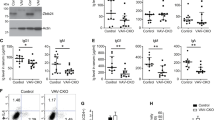Abstract
MHC class II deficiency patients are mutated for transcription factors that regulate the expression of major histocompatibility complex (MHC) class II genes. Four complementation groups (A–D) are defined and the gene defective in group A has been shown to encode the MHC class II transactivator (CIITA). Here, we report the molecular characterization of a new MHC class II deficiency patient, ATU. Cell fusion experiments indicated that ATU belongs to complementation group A. Subsequent mutation analysis revealed that the CIITA mRNA lacked 84 nucleotides. This deletion was the result of the absence of a splice donor site in the CIITA gene of ATU. As a result of this novel homozygous genomic deletion, ATU CIITA failed to transactivate MHC class II genes. Furthermore, this truncated CIITA of ATU did not display a dominant negative effect on CIITA-mediated transactivation of various isotypic MHC class II promoters.
Similar content being viewed by others
Author information
Authors and Affiliations
Additional information
Received: 3 June 1999 / Revised: 29 July 1999
Rights and permissions
About this article
Cite this article
Peijnenburg, A., Van den Berg, R., Van Eggermond, M. et al. Defective MHC class II expression in an MHC class II deficiency patient is caused by a novel deletion of a splice donor site in the MHC class II transactivator gene. Immunogenetics 51, 42–49 (2000). https://doi.org/10.1007/s002510050007
Issue Date:
DOI: https://doi.org/10.1007/s002510050007




